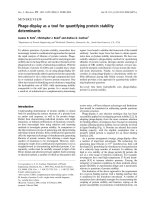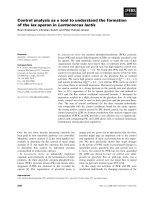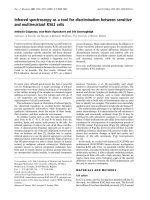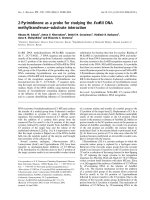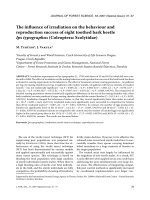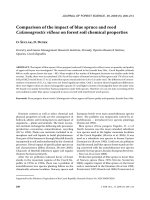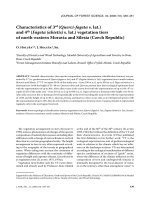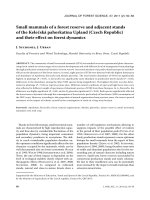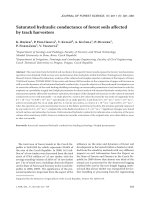Báo cáo lâm nghiệp: "Wedge prism as a tool for diameter and distance measurement" ppsx
Bạn đang xem bản rút gọn của tài liệu. Xem và tải ngay bản đầy đủ của tài liệu tại đây (167.97 KB, 4 trang )
J. FOR. SCI., 54, 2008 (3): 121–124 121
JOURNAL OF FOREST SCIENCE, 54, 2008 (3): 121–124
e wedge prism is a widely used small tool for
the measurement of basal area, mainly in diameter
at breast height (dbh). It is one of the tools based on
the method invented by the Austrian forester Bit-
terlich (K et al. 1972). e principle is an angle
counting of stems using the ratio of the diameter to
the distance between the measured stem and the
observer (the centre of the sample plot). ere are
two ways of projecting the angle:
– By prolonging two lines of sight from the eye
through two points whose lateral separation is
fixed, both of which are in the same horizontal
plane and both of which are at the same fixed
distance from the eye (H et al. 2003),
– By deviating the light rays from the tree through
a fixed angle (wedge prism).
The principle is that the given ratio between
widths at a certain distance from the eye. e ratio
is determined with an angle gauge according to the
trigonometric function (see Fig. 1).
a (a)
α = 2arctg –––– = 2arctg ––––
2b 2(b)
To calculate the basal area of trees per hectare the
following formula is used:
a
G = 2,500
(
––
)
2
M = cM
b
where: c – quotient,
M – number of countable trees whose angle is wider
than α or that lie precisely on the borderline
(K et al. 1972; Š 2000).
e quotient is equal to 1 for the ratio 1:50 between
the segment a and the segment b (B 1958
in K et al. 1972; B 1984). is quo-
tient is very convenient because the ratio enables
to measure distances or diameters easily using the
wedge prism. e ratio means that the tree is in the
borderline if the distance in meters is a half of the
diameter in centimetres. If an observer is 23 meters
from the tree and the tree is in the borderline, so its
diameter is 46 etc. e fact enables to measure the
diameters at certain heights of standing trees com-
monly inaccessible for other measuring devices. e
use of the wedge prism is based on the same principle
as the use of the Bitterlich mirror relascope (Wide
Scale) for measuring diameters on upper stems
(S 2002, 2005).
e measures using the quotient 1 is only one of
more possibilities. For instance if we use the wedge
Wedge prism as a tool for diameter and distance
measurement
L. Š, D. Z
Faculty of Forestry and Wood Sciences, Czech University of Life Sciences Prague, Prague,
Czech Republic
ABSTRACT: e wedge prism, which is generally used for the measurement of basal area in diameter at breast height,
is also a tool for the measurement of distance as well as for the measurement of diameters at a certain height of the
stem, in the upper stem. Measurements using the wedge prism are based on the same principle as measurements using
Bitterlich mirror relascope. is method is appropriate for non-destructive determination of stem volume. Moreover,
the wedge prism can be used for the sorting of logs in standing trees when the small end of expectant assortment has
to be known. As the wedge prism is a common tool for foresters, its usage seems to be larger than only the measure-
ment of basal area.
Keywords: wedge prism; upper stem diameter measurement; distance measurement; log sorting
122 J. FOR. SCI., 54, 2008 (3): 121–124
prism with the quotient (basal area factor) 4, the di-
ameter in centimetres is equal to the distance from
the tree in meters times 25.
Hypothesis and method
If the distance between the diameter at a certain
height and the observer is known and the diameter
is shown through the wedge prism on the borderline,
the diameter is easily countable with the quotient
equalling 1. e distance is measured with a telem-
eter, the height with a hypsometer. It is possible to
measure the horizontal distance from the tree and
the angle to a certain height when the diameter lies
on the borderline. e method was also described
for determining the tree diameter at breast height
(B 1996).
For testing the accuracy of the method the laser
telemeter was used and then the measured diameter
was measured using the calliper with one-centimetre
scale. Firstly, the test was realized in “laboratory”
conditions when the individual blocks of stems
were placed to windows of a building (height from
5 to12 m) then finding the distance when the blocks
were on the borderline. e distance was measured
using the laser telemeter with half-a-meter scale.
e diameter was calculated and compared with the
control measure using a calliper. Secondly, the test
was realized in natural conditions on sharp slopes
(more than 30°). The slopes enabled the control
using the calliper. e diameters were measured at
the stem height of 1.50 m, the observer stood in the
lower part of the slope so the slope alternated the
inaccessible height of the stem. Complete results are
shown in Table 1.
RESULTS
55 diameters were measured in “laboratory” condi-
tions, 55 diameters in forests.
Differences between diameters measured with a
wedge prism and diameters measured with a cal-
liper were tested using the paired t-test. We tested
a hypothesis that the mean difference between the
used measuring methods is equal to zero. Results are
shown in Table 2.
ere are statistically significant differences for
laboratory conditions. We can also compute confi-
dence intervals for the mean difference. Denote by
d average difference, s standard deviation of differ-
ences, n number of observations and t
n–1
(α) critical
value of Student’s distribution with n – 1 degrees of
freedom. Under assumption of the normal distribu-
tion of differences, the interval
st
n–1
(α)
d ± ––––––––
√ n
borderline
(b)
(a)
a
α
b
Fig. 1. Geometry of the angle gauge
Table 1. Average values and their differences
Diameter measured optically
with wedge prism
Diameter measured
with calliper
Difference
Standard deviation
of differences
In “laboratory” 33.95 34.24 –0.29 0.88
In forest 38.80 38.62 0.18 0.92
Total 36.38 36.43 –0.05 0.93
Table 2. Paired t-test for differences
Test statistic Significance level
In “laboratory”
–2.47 0.017
In forest
1.46 0.151
Total
–0.62 0.540
J. FOR. SCI., 54, 2008 (3): 121–124 123
covers the value of mean difference with probability
of 1 – α. us, we have a 95% confidence interval
(–0.53; –0.05) for differences in laboratory condi-
tions.
CONCLUSION
e optical measuring of the diameter at various
heights of stem using the wedge prism as a tool for
measurement is a sufficiently accurate method for
measurement and can be used for measuring the
diameters in the upper stem.
Use of the method
Using the wedge prism is easier than using the mir-
ror relascope because one checks only one vertical
plain while the mirror relascope needs two vertical
plains to be checked. e method gives a possibil-
ity of calculating the volume of the tree without its
destruction. e non-destructive method is essential
for calculating the volume in forests (virgin forests)
where the yield tables do not exist or for the revision
of the existing tables. e stem is divided into parts
and they are calculated using the common method
of calculating the logs such as Huber’s or Smalian’s
formula for log volume (K et al. 1972; Š
2000). e sum of log volumes gives the volume of
the stem. e form height is a ratio between the stem
volume and the diameter at breast height.
e method of measuring the diameter at a certain
height of the tree is also appropriate for the sorting
in standing trees. For sorting one needs to know the
diameter in the small end of logs. According to the
Recommended Rules for Log Measuring and Sorting
in the Czech Republic (K 2002) the border
diameter of small end for sliced veneer assort-
ments is 45 (48) cm. 45 (48) cm mean the distance
22.5 (24) m when the diameter lies on the borderline.
us if the diameter measured from this distance lies
on the borderline at a certain height or is even larger,
the log fulfils the criterion to be sorted to the sliced
veneer log. If the wedge prism is completed with
the hypsometer, which can measure the distance as
well, for instance by laser, the method of sorting is
sufficiently precise and cheap.
In addition, the method can be used for the meas-
uring of distances in forests (from 1 to 50 m). If the
tree is marked by two points or two lines whose
distance is according to the rule listed above, i.e.
distance we want to measure in meters twice in cen-
timetres and the lower point (line) optically appears
in the position of the upper point, our position is at
a given distance. e wedge prism in this situation is
held vertically (rotated through an angle of 90° from
the normal position for basal area measurement).
e same principle is used for the alignment of
circular sample plots (H 1994). If the plot centre
is fixed by the pole marked with circlets at a given
distance, the distance from the centre to the plot
border is measured using the same principle as
mentioned above.
e wedge prism seems to have more chances to
be used than only for the measurement of basal area.
However, its use is influenced by the ability of the
observer to determine precisely the border tree, in
our cases the borderlines. Any error in measurement
leads to a bigger error in calculated results. From this
aspect the proposed methods for larger usage of the
wedge prism should be proved experimentally in
various types of stands and on various tree species.
Ref erences
BITTERLICH W., 1996. More on the ‘sighting angle-gauge’
– complementing the Relascope. Österreichische Forstzei-
tung, 107: 8–9.
BITTERLICH W., 1984. e Relascope Idea. Relative Meas-
urements in Forestry, Commonwealth Agricultural Bu-
reaux, Slough: 242.
BOWERS S., 2004. Tool for measuring your forests. e
Woodland Workbook, EC 1129. Corvallis, Oregon, Exten-
sion & Station Oregon State University: 8.
HALE A.M., 1994. Construction of a circular plot sampling
instrument. Ohio Journal of Science, 94: 113–115.
HUSH B., BEERS T.W., KERSHAW J.A., 2003. Forest Mensu-
ration. New Jersey, John Wiley et Sons, Inc.: 443.
optical shift
real position
Fig. 2. Marking the tree and optical shift of the image visible
in the wedge prism
124 J. FOR. SCI., 54, 2008 (3): 121–124
KOLEKTIV, 2002. Doporučená pravidla pro měření a třídění
dříví v České republice. Trutnov, Svaz zaměstnavatelů
dřevozpracujícího průmyslu, Společenstvo dřevozpracujících
podniků v ČR, Česká asociace podnikatelů v lesním
hospodářství, Lesz ČR, s. p.: 41.
KORF V., HUBAČ K., ŠMELKO Š., WOLF J., 1972. Dendro-
metrie. Praha, SZN: 371.
SALAS C.E., 2002. Ajuste y validación de ecuaciones de volu-
men para un relicto del bosque de Roble-Laurel-Lingue.
Bosque, 23: 81–92.
Optický klín jako nástroj pro měření průměrů a vzdáleností
ABSTRAKT: Optický klín, který se obvykle používá pro měření kruhové základny v prsní výšce, je také nástroj pro
měření vzdáleností nebo pro měření průměrů v různých výškách stromů. Měření s použitím optického klínu je rea
-
lizováno na základě stejného principu jako měření s použitím Bitterlichova zrcadlového relaskopu. Tato metoda je
vhodná pro nedestruktivní určení objemu kmene. Navíc je možné optický klín použít pro sortimentaci ve stojících
porostech, kdy musíme znát průměr čepu na očekávaných sortimentech. Protože optický klín je pro lesníky obvyklým
nástrojem, jeho použití může být širší než pouze pro měření kruhové základny.
Klíčová slova: optický klín; měření průměrů v nedostupných výškách; měření vzdáleností; sortimentace
SALAS C.E., REYES S.M., BASSADE C.E., 2005. Medición
de diámetros fustales con relascopio y forcípula finlandesa:
efectos en la estimación de volumen. Bosque, 26: 81–90.
ŠMELKO Š., 2000. Dendrometria. Zvolen, Vydavateľstvo
TU: 405.
Received for publication November 5, 2007
Accepted after corrections January 24, 2008
Corresponding author:
Ing. L Š, Česká zemědělská univerzita v Praze, Fakulta lesnická a dřevařská, 165 21 Praha 6-Suchdol,
Česká republika
tel.: + 420 224 383 718, fax: + 420 224 381 860, e-mail:
